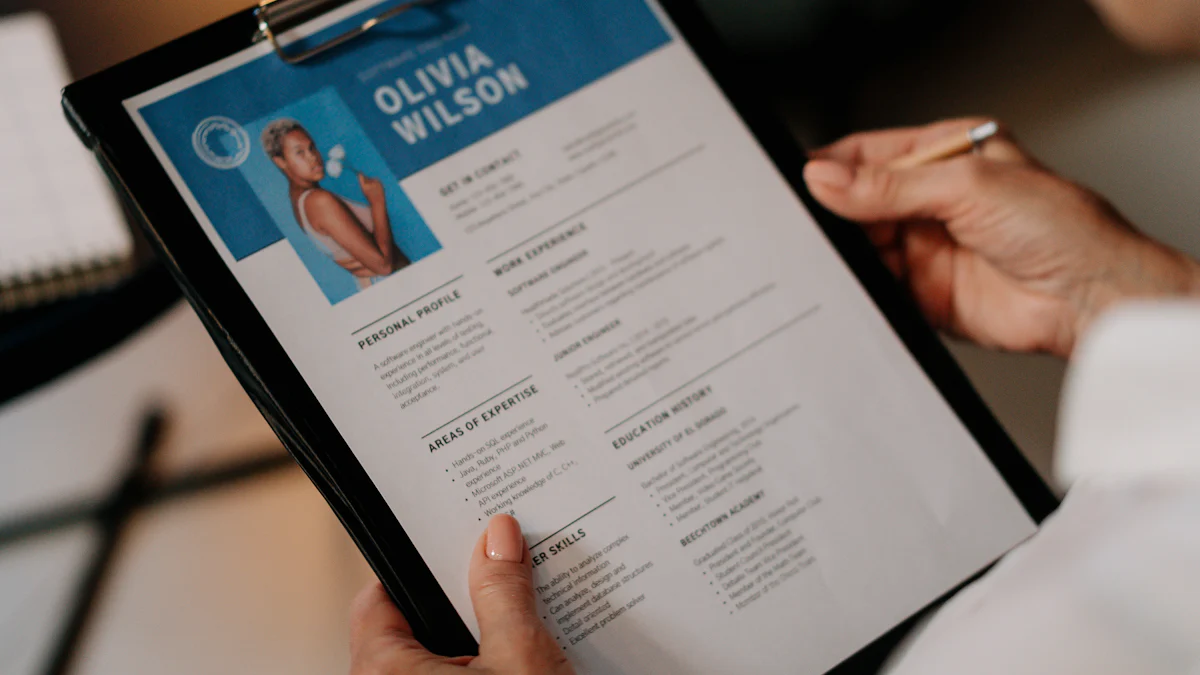How Long Should Your Resume Be in 2025
Try Aihirely for
Smarter Interview Prep
Experience real-time AI support tailored to your Resume.
Boost your confidence and ace every question with
AI Mock Interview.

Image Source: pexels
Your resume length can make or break your first impression in 2025. Recruiters spend seconds scanning resumes, so keeping it concise is key. Most resumes average 1.7 pages, with two-page resumes gaining popularity. Whether you’re wondering how long should a resume be or aiming to stand out, relevance and clarity matter most.
📊 Quick Stats for 2025:
Statistic Description Value Average resume length in 2025 1.7 pages Percentage of one-page resumes 43% Percentage of two-page resumes 47%
Modern trends like AI optimization and personal branding also shape how resumes are crafted. A well-structured, tailored resume can help you land that dream job.
Key Takeaways
-
Make your resume short. Use one page for beginners and two pages for experienced roles.
-
Show important experience. List recent jobs and measurable successes to impress recruiters.
-
Match your resume to the job. Add only useful details that fit the job you want.
Why Does Resume Length Matter?

Image Source: pexels
First impressions and recruiter preferences
Your resume is often the first thing a recruiter sees. It’s your chance to make a strong impression. Recruiters spend only a few seconds scanning each resume, so you need to grab their attention quickly. A resume that’s too long can feel overwhelming, while one that’s too short might seem incomplete. Striking the right balance shows you understand how long should a resume be for your experience level.
Recruiters also prefer resumes that are easy to read. Use clear headings, bullet points, and concise language. This makes it easier for them to spot your skills and achievements. Remember, a well-organized resume can set you apart from other candidates.
Balancing detail with brevity
You might wonder how to include enough information without making your resume too long. The key is to focus on what’s relevant. Highlight your most recent roles and accomplishments. Use targeted keywords that match the job description. For example:
-
Keep it simple and easy to read.
-
Limit each section to bullet points or short phrases.
-
Highlight quantifiable achievements to showcase your impact.
This approach ensures you provide enough detail without overwhelming the reader. It’s about quality, not quantity.
Avoiding common mistakes in resume length
Many people make mistakes when deciding how long their resume should be. Some include every job they’ve ever had, even if it’s not relevant. Others leave out important details to keep it short. Avoid these pitfalls by tailoring your resume to the job. Remove outdated or redundant information. Focus on your most recent and impactful experiences.
A good rule of thumb? If a detail doesn’t add value, leave it out. This keeps your resume concise and ensures every word counts.
How Long Should a Resume Be Based on Experience?
One-page resumes for entry-level candidates
If you’re just starting your career, a one-page resume is your best bet. It keeps things simple and focused, which is exactly what hiring managers want. You don’t need to include every detail of your life—just the essentials. A concise resume highlights your skills and experiences without overwhelming the reader.
Here’s why a one-page resume works so well:
-
It’s easy to scan, which is crucial when recruiters are reviewing hundreds of applications.
-
It forces you to focus on what truly matters, like your education, internships, and relevant skills.
For example, a recent college graduate might include coursework, GPA, and a strong objective statement. Check out this table for ideas:
| Resume Type | Features That Work |
|---|---|
| Recent College Graduate | - Includes relevant coursework, skills, GPA, and a resume objective.- Uses action verbs and quantifiable achievements in bullet points. |
| New College Graduate | - Emphasizes a strong objective statement that reflects personality and skills.- Focuses on standing out among applicants for internships. |
Two-page resumes for mid-level professionals
If you’ve been working for 10-15 years, a two-page resume is ideal. It gives you enough space to showcase your career progression and key achievements. Recruiters actually prefer two-page resumes over one-page versions for mid-level roles.
Focus on the last decade of your career. Highlight promotions, major projects, and measurable results. This approach shows how you’ve grown and what you bring to the table.
Three-page resumes for senior or technical roles
For senior professionals or technical experts, a three-page resume might be necessary. If you’ve led large teams, managed complex projects, or have extensive technical expertise, you’ll need the extra space. Just make sure every detail adds value.
Even with three pages, keep it organized. Use clear headings and bullet points to make it easy to read. Remember, the goal is to show your depth of experience without losing the reader’s attention.
Factors That Influence Resume Length
Industry-specific standards
Your industry plays a big role in determining how long your resume should be. Some fields demand more detail, while others value brevity. For example, technical fields like IT or engineering prioritize business impact first, followed by technical details. Healthcare resumes often include licenses, certifications, and patient outcomes. In academia, CVs can stretch up to 15 pages to document research and teaching experience.
Here’s a quick breakdown:
| Industry | Resume Length Guidelines |
|---|---|
| Technical Fields | Focus on business impact first, followed by technical details; avoid excessive length. |
| Healthcare | Include licenses and certifications relevant to the role; emphasize patient outcomes. |
| Academia | CVs can extend up to 15 pages for detailed documentation of research and teaching. |
Creative industries, on the other hand, often require concise resumes. You might need to showcase your portfolio and focus on business outcomes like increased engagement or revenue growth.
-
Creative professionals typically stick to one page.
-
Art directors and photographers may extend to two or three pages.
Job description and role requirements
The job description is your cheat sheet for figuring out how long your resume should be. If the role demands specific skills or certifications, include them. For technical or senior roles, you might need extra space to highlight your expertise. For entry-level or creative roles, keep it short and sweet.
Tailoring your resume to the job ensures you only include relevant details. This approach not only keeps your resume concise but also shows recruiters you’ve done your homework.
Geographic and cultural considerations
Where you’re applying can also influence resume length. Different countries have unique preferences. For instance, resumes in the U.S. are typically one or two pages, focusing on achievements. In Germany, resumes are also concise but may include more detail or follow a CV format. Japan prefers a specific two-page format with comprehensive information.
Here’s a quick comparison:
| Country | Resume Length Preference | Cultural Insight |
|---|---|---|
| Germany | Photo customary on resume | Emphasis on concise communication, typically one to two pages. |
| France | Photo can be advantageous, not compulsory | Similar preference for brevity, focusing on relevant details. |
| Australia | Commonly three to five pages, two pages acceptable | Variation based on job requirements and experience level. |
| Canada | Ideal length is one page | Aligns with the U.S. preference for concise resumes. |
| Japan | Usually two pages, specific format required | Emphasis on comprehensive information, traditionally prepared manually. |
| UK | Comprehensive overview often exceeding two pages | Cultural preference for detailed resumes, allowing for in-depth qualifications. |
Understanding these preferences can help you tailor your resume to meet expectations, no matter where you’re applying.
Practical Tips for Optimizing Resume Length

Image Source: pexels
Focus on relevance and recent experience
Your resume should focus on what matters most—your recent and relevant experience. Employers care about how your skills align with the job. If you’ve had a non-linear career path, consider a skills-based approach. This highlights your abilities and strengths. For project-heavy roles, a project-based approach works best. It showcases tangible achievements and outcomes.
| Strategy | Description |
|---|---|
| Skills-based approach | Focuses on abilities and strengths, useful for non-linear career paths, highlighting relevant skills. |
| Project-based approach | Centers on tangible achievements and contributions, showcasing hands-on experiences and outcomes. |
Use bullet points for clarity
Bullet points make your resume easier to read. They break down complex information into smaller, digestible pieces. This helps recruiters quickly spot your qualifications.
-
Bullet points enhance clarity by organizing details effectively.
-
They promote conciseness, letting you communicate achievements succinctly.
-
Highlighting key accomplishments ensures recruiters notice your strengths.
Eliminate outdated or redundant information
Outdated details can clutter your resume. Remove personal information like hobbies or marital status unless it’s relevant to the job. Avoid listing unrelated work experience or skills that no longer apply. This keeps your resume focused and professional.
Highlight achievements over responsibilities
Employers want to see what you’ve accomplished, not just what you were responsible for. Replace generic job duties with specific achievements. For example:
| Type | Example |
|---|---|
| Quantitative | ”Reconciled end-of-day receipts with cash and credit transactions to account for daily sales averaging $1,500.” |
| Qualitative | ”Organized database to track business contacts and was commended for attention to detail and accuracy.” |
Leverage formatting to maximize space
Smart formatting can make your resume look polished and professional. Use standard margins (0.5” to 1”) and readable fonts like Arial or Calibri in 11-12pt size. Adjust line spacing to 1.0 for a compact layout. Minimize white space between sections and use single-line entries for supporting credentials. These tweaks help you fit more information without overwhelming the reader.
💡 Pro Tip: Prioritize relevant details and transform generic statements into impactful achievements to make every word count.
The ideal resume length in 2025 depends on your experience, industry, and the job you’re targeting. A tailored resume that aligns with hiring manager expectations can make all the difference. Use metrics to show your impact, highlight relevant skills, and include modern design elements like clear fonts or ATS-friendly formats.
Regular updates keep your resume fresh and ready for opportunities. Adding achievements as they happen ensures accuracy and relevance. Staying on top of trends, like AI optimization and skills-based formats, boosts your chances of standing out. Tailoring your resume to specific roles also helps you pass ATS filters and impress hiring managers.
So, how long should a resume be? It’s not just about length—it’s about making every word count. Keep it concise, relevant, and visually appealing to leave a lasting impression in 2025.
FAQ
How do I know if my resume is too long?
Ask yourself: Does every detail add value? If not, trim it. Focus on recent, relevant achievements. Recruiters prefer concise resumes that highlight your impact.
💡 Tip: Stick to one or two pages unless you’re in a senior or technical role.
Can I use a creative design for my resume?
Yes, but only if it fits your industry. Creative fields like design or marketing welcome unique layouts. For corporate roles, stick to clean, ATS-friendly formats.
🖌️ Pro Tip: Balance creativity with readability. Use clear fonts and avoid overloading with graphics.
Should I include all my work experience?
No, you don’t need to list every job. Focus on roles that align with the job you’re applying for. Irrelevant or outdated positions can clutter your resume.
✅ Note: Highlight achievements from the last 10-15 years for mid-level or senior roles.
